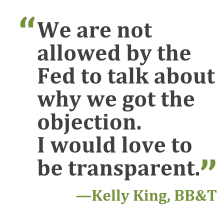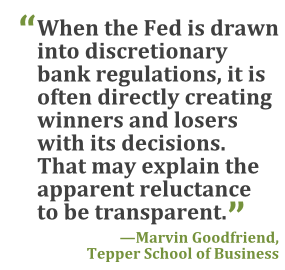The Federal Reserve this month will take a step toward revealingmore about its oversight of the financial system, an area where thecentral bank has yet to match the strides it has taken towardtransparency in monetary policy.
|With the scheduled publication of annual stress-test findings inMarch, the Fed will for the first time describe how rising interestrates could affect the health of the nation's biggest banks.
|Last year, the Fed didn't disclose results of a similar test,even though the U.S. Treasury's Office of Financial Research hadflagged interest-rate risk as the one code-red concern in thefinancial system. Almost four years after the Dodd-Frank Act gavethe Fed unprecedented authority over the banking industry,Democrats and Republicans alike in Congress are demanding morecommunication on financial risk.
|“For too long, financial watchdogs were asleep on the job andAmerican taxpayers paid the price,” said Sherrod Brown, an OhioDemocrat on the Senate Banking Committee. “There is not nearlyenough transparency and accountability in their oversight of WallStreet.”
Fed officials download billions of pieces of data on loan andsecurities portfolios as part of their annual stress test, whichmeasures an institution's readiness to withstand adversity. Thisyear the test expands to the 30 biggest banks, from 18 last year.The Fed Board of Governors has set up a special office to monitorfinancial stability, and a committee of supervisors,payment-systems experts, and economists to study risks across thelargest banks all at once. Neither the supervisors nor the riskwatchers are telling the public much about what they'velearned.
|Likewise, the Fed has said little about its new supervision ofnon-bank financial groups General Electric Capital Corp.,Prudential Financial Inc., and American International Group Inc.Nor does the Fed have a formal way of communicating how it mightuse supervisory powers to head off financial bubbles. The specialcross-bank group, known as the Large Institution SupervisionCoordinating Committee, doesn't publish minutes or a report.
|“It is either a gaping hole, or they are very busy trying tomaximize their discretion,” said Adam Posen, a former member of theBank of England's monetary policy committee and now president ofthe Peterson Institute for International Economics in Washington.Transparency boosts “market discipline, and you want that to beyour corrective as much as anything else.”
|Pressure to Reveal More
|Representative Scott Garrett, a New Jersey Republican on theHouse Financial Services Committee, introduced a bill this year that would force the Fed to saymore. Senator Elizabeth Warren of Massachusetts and RepresentativeElijah Cummings of Maryland, both Democrats, wrote to Fed ChairJanet Yellen Feb. 12 seeking more accountability and transparencyon bank enforcement action.
|Yellen, in a Senate hearing Feb. 27, told Warren it would be“appropriate for us to make changes” on the Fed board's input intoenforcement actions.
|Warren also pressed Yellen for more disclosure about settlementson enforcement actions. “The Fed doesn't have to wait for Congressto do that; you could voluntarily adopt that public disclosurenow,” she said.
|“I agree with you, it is important for us to disclose more andto disclose as much as we can,” Yellen said, adding that the Fedwould “try to provide more information.”
||Under Yellen's predecessor, Ben S. Bernanke, the central bankboosted transparency in monetary policy. Bernanke began holdingquarterly press conferences, the central bank described itsinflation goal numerically for the first time, and officials nowpublish their forecasts for the policy interest rate.
|Bernanke also took the step, after an intense internal debate,of publishing results of bank capital adequacy after the stresstest of 2009, when the financial system was still fragile.
|The Fed “has taken significant steps in the past five years toincrease transparency of supervision and regulation,” spokesmanEric Kollig said in an e-mailed statement.
These include “releasing increasingly detailed, firm-specificdata as part of the annual stress tests and qualitative informationregarding firms' capital planning processes; providing detailedsummaries of staff and Board member meetings with outside groupsregarding regulatory matters; and holding more Board meetings opento the public on regulations,” Kollig said.
|Capital Levels
|The Fed uses stress testing to make sure banks can manageextraordinary risks and reserve sufficient capital, instead ofpaying too much of it out as dividends.
|The tests reveal the capital levels of banks after they arewrung through a “severely adverse scenario,” such as a deeprecession. The Fed also reveals hypothetical loss rates on variouscategories of loans, on trading books for six banks, and—for thefirst time this year—counterparty risk for eight banks. All of thatis a large step for a central bank that once said almost nothingabout risks inside the largest banks.
|Still, opacity in the process remains.
|The Fed ordered JPMorgan Chase & Co. and Goldman Sachs GroupInc. to resubmit their capital plans last year, citing “weaknesses”in their processes though not in their capital adequacy. It neverspecified what those weaknesses were. The Fed objected to BB&TCorp.'s capital plan “based on a qualitative assessment,” eventhough the bank had one of the highest capital scores among the 18banks tested.
|As it turns out, JPMorgan was asked for more details on itsmodels and portfolios, according to a person familiar with theresubmission. Goldman Sachs Chief Financial Officer Harvey Schwartzsaid on a conference call that it was “incorporating certainenhancements” in its stress-test process.
|BB&T's Chief Executive Officer Kelly King said he objects tothe scant details provided by the Fed.
|“This is something I disagree with,” King said in an interview.“We are not allowed by the Fed to talk about why we got theobjection. We cannot be transparent. I would love to betransparent.”
|The Fed said all of the 18 largest banks last year received“detailed assessments” of their capital planning, includingfeedback on areas where the plans and processes need to bestrengthened.
|Transparency Varies
|Bloomberg News in October requested through the Freedom ofInformation Act the aggregate number of supervisory orders inassessment letters issued following the past four stress tests. TheFed denied the request.
|Bloomberg also requested results for the rising-interest-ratescenario in the 2013 stress tests. The Fed denied the request,saying about 66 pages of information was “exempt from disclosure.”This year, the Fed will show it for the first time.
|The Fed's supervisory actions have more targeted effects thanits monetary-policy initiatives do, and that helps account for thediffering approaches to transparency, said Marvin Goodfriend, aformer Richmond Fed policy adviser.
|“The Fed is comfortable with transparency on monetary policybecause it is not about individual firms or markets, but aboutcreating macroeconomic conditions for prosperity in general,” hesaid.
||“When the Fed is drawn into discretionary bank regulations andregulatory policy, it is often directly creating winners and loserswith its decisions,” said Goodfriend, who is now a professor atCarnegie Mellon University's Tepper School of Business inPittsburgh. “That makes central bankers uncomfortable, and mayexplain the apparent reluctance to be more transparent on suchmatters.”
|Since the stress tests were introduced in 2009, the Fed hasstruggled over where to draw the line so it can give the public asense of financial-system health without undermining confidence inany particular bank.
|In August, the Board of Governors took the unexpected step ofreporting on how the largest banks, without naming themindividually, were handling the stress tests. The conclusion: Allof the large banks that participated in the stress test “facedchallenges across one or more” of five areas. The report may not bean annual occurrence.
|Proprietary Information
|“I am sensitive to the proprietary nature of individual bankissues,” said Karen Shaw Petrou, managing partner of FederalFinancial Analytics in Washington, a firm that consults for largebanks on financial regulation. Petrou said she “would like to see alot more transparency” in how the Fed is devising sweeping newrules.
|Garrett's legislation would require the Fed to perform acost-benefit analysis on new rules, as well as disclose theaggregate number of supervisory letters sent to banks, and providean independent review of the stress tests.
|The Dodd-Frank Act did contemplate a need for moreaccountability on Fed oversight, creating the position of vicechairman for supervision at the Fed. That job comes with astatutory obligation to testify before House and Senate committeestwice a year.
|The White House has never appointed anybody to the seat, thoughPresident Barack Obama's first appointee to the Fed board, DanielTarullo, fills that role as the governor in charge of supervisionand regulation.
|Macroprudential Tools
|The Fed, like many central banks around the world, is alsoconsidering a suite of so-called “macroprudential” tools that couldtighten credit across entire markets without raising interestrates.
|The Fed has already taken aim at one market as itslow-interest-rate policy boosts prices on everything from stocks tohigh-risk loans. Writing regulatory guidance in March 2013 on thebooming leveraged-loan market, officials spelled out whatdebt-to-cash-flow levels would raise concern. Usually, theirguidance isn't numerically specific.
|Minutes from December's Federal Open Market Committee (FOMC)meeting show some members grasping for ways to communicate howtheir concerns about financial stability mesh with their currentmonetary policy of keeping the benchmark lending rate nearzero.
|One member suggested that financial stability considerations beincorporated “into forward guidance for the federal funds rate andasset purchases.”
|Yellen led Bernanke's communications subcommittee that pushedfor more monetary-policy transparency. The political and economicbenefits of having a way to discuss the potential use and impact offinancial stability tools and bank rules won't be lost on her, saidMichael Bordo, director of the Center for Monetary and FinancialHistory at Rutgers University in New Brunswick, New Jersey.
|“Picking winners and losers in secret, justifying thingsex-post, and not laying out any criteria—that is back to the olddays” when central bankers thought ambiguity was an advantage, saidBordo. “Just having to report to the Congress and the public onthis function is a really good plan.”
|Copyright 2018 Bloomberg. All rightsreserved. This material may not be published, broadcast, rewritten,or redistributed.
Complete your profile to continue reading and get FREE access to Treasury & Risk, part of your ALM digital membership.
Your access to unlimited Treasury & Risk content isn’t changing.
Once you are an ALM digital member, you’ll receive:
- Critical Treasury & Risk information including in-depth analysis of treasury and finance best practices, case studies with corporate innovators, informative newsletters, educational webcasts and videos, and resources from industry leaders.
- Exclusive discounts on ALM and Treasury & Risk events.
- Access to other award-winning ALM websites including PropertyCasualty360.com and Law.com.
*May exclude premium content
Already have an account? Sign In
© 2024 ALM Global, LLC, All Rights Reserved. Request academic re-use from www.copyright.com. All other uses, submit a request to [email protected]. For more information visit Asset & Logo Licensing.






